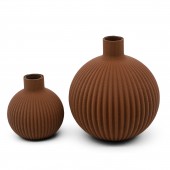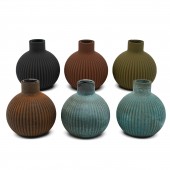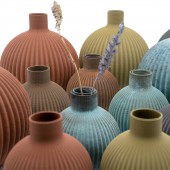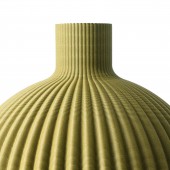
| THE AWARD |
| CATEGORIES |
| REGISTRATION |
| SUBMIT YOUR WORK |
| ENTRY INSTRUCTIONS |
| TERMS & CONDITIONS |
| PUBLICATIONS |
| DATES & FEES |
| METHODOLOGY |
| CONTACT |
| WINNERS |
| PRESS ROOM |
| GET INVOLVED |
| DESIGN PRIZE |
| DESIGN STORE |
| THE AWARD | JURY | CATEGORIES | REGISTRATION | PRESS | WINNERS | PUBLICATIONS | ENTRY INSTRUCTIONS |
Ribbing Vase by Lihsing Wang |
Home > Winners > Design #139651 >Interview |
 |
|
FS: What is the main principle, idea and inspiration behind your design?
LW: The Ribbing is inspired from the rib knit, a soft, flimsy and stretchy fabric type. I took this feature and applied it upon the solid form; woven it by metal filament with a 3D printer that simulates a fabric-like surfacing.
FS: What has been your main focus in designing this work? Especially what did you want to achieve?
LW: The uwu design studio aims for high-quality production, waste reduction and cost efficiency in production. In order to achieve that goal in the ribbing vase project, I adapted the use of 3D printers and computational software, Grasshopper. After several rounds of testing, I figured out using default slicer software to generate G-code for print is inefficient. Instead, by utilizing G-code directly in Grasshopper allows me to fully control the 3D printer and optimize the production. More specifically, the scripted data transforming my design into a series of curves and paths have turned into the assigned route of the 3D printer. As for the material used, ribbing was made from metal-filled metal filament, HTPLA.
FS: What are your future plans for this award winning design?
LW: The ribbing vase will be launched in early July 2022 only in The United State region. We provide the ribbing vase options in two sizes and three materials on each that are copper, iron, bronze. And the small size will be available on the dates above but the large size will be available in August 2022 or later.
FS: How long did it take you to design this particular concept?
LW: The ribbing vase is a branch of design in my continuous research on digital manufacture topic starting from 2019. Although this is an ongoing research, this ribbing vase project took about a year to develop.
FS: Why did you design this particular concept? Was this design commissioned or did you decide to pursuit an inspiration?
LW: This project is the first product for uwu design studio. Our goal is to embody warm, delightful and amiable feelings into the products and share it with our customers. uwu focuses on commodities designed and manufactured using general 3D printers to achieve in-house production.
FS: Is your design being produced or used by another company, or do you plan to sell or lease the production rights or do you intent to produce your work yourself?
LW: The making process attains zero waste, zero emission, fully sustainable and self-reliant action by implementing additive manufacturing technology into our production pipeline. Ribbing vases need to fit in 3D printers without any support material and can be manufactured on a small scale by consumer-driven 3D printers. We would also love to support regional markets by manufacturing our products locally. Thus, the ribbing vase was fully designed, manufactured, and assembled in Brooklyn, New York.
FS: What made you design this particular type of work?
LW: Since 3D printing is getting more accessible for people and designers. Companies and small studios started to mass-produce their product using the 3D printer and selling on the market. This idea,using 3D printers into production, not only saves energy on transportation but is also beneficial to young entrepreneurs for starting their business by reducing investment in the three party manufacturing company and gaining more control on production.
FS: Where there any other designs and/or designers that helped the influence the design of your work?
LW: None.
FS: Who is the target customer for his design?
LW: Uwu design studio’s target audience is young women pursuing unique styles.
FS: What sets this design apart from other similar or resembling concepts?
LW: Ribbing vase is not just another 3D printed product in the market. In fact, this is a brand new manufacturing framework taking computational design into account for optimizing the product’s quality.
FS: How did you come up with the name for this design? What does it mean?
LW: The Ribbing is inspired from the rib knit, a soft, flimsy and stretchy fabric type.
FS: Which design tools did you use when you were working on this project?
LW: Rhino, Grasshopper, various GH’s plug-in, 3D printer, python.
FS: What is the most unique aspect of your design?
LW: Ribbing vase as a floral display medium also speaks for itself with binary visual language in any spatial setting. Its vertical ribs pattern change their contour as they adapt along the curvy shapes, creating a constant momentum on a solid surface.
FS: Who did you collaborate with for this design? Did you work with people with technical / specialized skills?
LW: None
FS: What is the role of technology in this particular design?
LW: 3D printing plays an impotent role in mass producing this product.
FS: Is your design influenced by data or analytical research in any way? What kind of research did you conduct for making this design?
LW: None
FS: What are some of the challenges you faced during the design/realization of your concept?
LW: In order to manufacture ribbing vases with high-quality production, waste reduction and cost efficiency, I adapted the use of 3D printers and computational software, Grasshopper. After several rounds of testing, I figured out using default slicer software to generate G-code for print is inefficient. Instead, by utilizing G-code directly in Grasshopper allows me to fully control the 3D printer and optimize the production. More specifically, the scripted data transforming my design into a series of curves and paths have turned into the assigned route of the 3D printer.
FS: How did you decide to submit your design to an international design competition?
LW: More press features for my work is part of the reason but most importantly is getting feedback from academy awards.
FS: What did you learn or how did you improve yourself during the designing of this work?
LW: Stay Hungry. Stay Foolish. Never be satisfied, and always push yourself.
FS: Any other things you would like to cover that have not been covered in these questions?
LW: None
FS: Thank you for providing us with this opportunity to interview you.
A' Design Award and Competitions grants rights to press members and bloggers to use parts of this interview. This interview is provided as it is; DesignPRWire and A' Design Award and Competitions cannot be held responsible for the answers given by participating designers.
| SOCIAL |
| + Add to Likes / Favorites | Send to My Email | Comment | View Press-Release |





